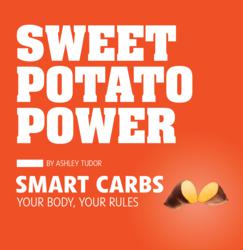Sweet Potato Power: An Interview with Ashley Tudor

/
|

One of the most common fears that the average person has when learning about a Paleo-type diet is that they will have to give up anything remotely sweet or starchy.
The mourning prompted by the prospective loss of carbs is akin to the wails of a five-year-old burying their beloved hamster, perhaps stuffed into a toilet paper tube (to be clear, dear reader, I mean the hamster, not the five-year-old, though who hasn’t occasionally wanted to stuff a screeching child into a toilet paper tube?).
We cling to our carbohydrates — and rightly so, for their ingestion produces happy chemicals that bathe us, Calgon-take-me-away style, in painkilling endorphins, “slot-machine-payoff” dopamine, and soothing serotonin. It’s the cheapest high around.
However, it’s a myth that Paleo-style eating means forsaking all carbs. Our ancestors and current-day foragers chowed down plenty of starchy tubers, for instance, especially during times when, say, walrus burgers or turtle nuggets were hard to come by. Sweet potatoes are one of the virtuous starchy tubers that undoubtedly sustained many an early human between trips to Mammoth Mart.
Sweet potatoes: Nutritional workhorses
In fact, argues Sweet Potato Power author Ashley Tudor, sweet potatoes are one of nature’s most perfect foods — surpassing even (yes!) — spinach and broccoli in their nutrient content, according to the Centre for Science in the Public Interest. They’re high in bioavailable beta-carotene, fibre, vitamin E, and anti-inflammatory chemicals.
The key to understanding sweet potatoes is twofold:
- They aren’t yams, even though we often call them that. Yams are rarely available in North America except at specialty stores.
- They aren’t regular potatoes. Though both originated somewhere in Central or South America, and though both belong to the order Solanales, regular potatoes are from the Solanacea family, aka the nightshade family that includes eggplants, tomatoes, peppers, and tobacco. Sweet potatoes (Ipomoea batata) are from the Convolvulaceae family, which also includes morning glories.
Sweet potatoes are a starchy carb source, yes, but they are slowly digested, well-used by the body, and full of beneficial nutrients.
Self-experimentation

Satsumaimo sweet potatoes
The book is not simply a monograph on the subject of sweet potatoes. It’s a testament to the power of self-experimentation.
As Ashley explains, sweet potatoes are simply a lens that focuses the larger picture — the importance of gathering data on and drawing conclusions about oneself.
In order to know what diet works for us, we have to learn about our bodies. Our responses. Our triggers.
This isn’t one of those “magic foods” books, where authors write like gushing teenagers about how an incredibly cute boy — sorry, single foodstuff (say, coconut oil, goji berries, or hummingbird milk) — will cure everything that ails anyone.
She’s careful to point out that not everyone can tolerate starchy carbohydrates in their diets. If, say, you’re pre-diabetic or diabetic, you may not do well with those foods. Or, in fact, you just might find that sweet potatoes treat your body better than fruit.
How to know? Why, be your own lab rat, of course.
In several chapters devoted to the science of self, she explores things like her blood glucose changes, even going as far to get a DexCom glucose meter implanted.
All carbs are not created equal
Along the way, Ashley experimented with other types of carbohydrates — the fructose in fruit, the sucrose in table sugar, etc.
She found that choosing the right type of carbohydrate — i.e. complex. starchy carbohydrate that broke down into glucose, not fructose — actually suppressed her appetite and kept her feeling satisfied, happy, and full.
Sweet potatoes produced the proverbial stick-to-your-ribs satisfaction. Conversely, fruit made her hungrier and processed sugar sent her on an all-out binge.
This is a key point: All carbs are not created equal. Our hormonal response to each type of carbohydrate is distinct and complex.
You’re not a “bad” or “weak” person if you can’t control your appetite after consuming, say, a can of soda. Your hunger is simply a pawn in your larger game of biochemistry.
Choose carbs carefully and you’ll feel fuller longer. Feeling fuller longer means you’ll eat less overall, and when you do eat, it won’t be a frantic Cookie-Monster-esque freakout.
Sweet potatoes: Also kitchen workhorses
As Ashley demonstrates in her wide-ranging selection of delicious recipes, sweet potatoes can become darn near anything — salads, side dishes, pasta substitutes, truffles, popsicles, and even sports drinks.
She discusses the culinary properties of each variety of sweet potato, and which one to choose for which dish.
Gentle reader, if you can find a satsumaimo sweet potato, grab it and roast it — it sweetens with toasted-caramel notes, and with the right recipe, tastes just like cake. You’ll likely find these in Asian markets. Look for the long, purple-skinned sweet potatoes with white flesh.
However, look around for other types too, such as the purple-fleshed sweet potato, which is also high in beneficial anthocyanins.
My interview with Ashley
I had the pleasure of interviewing Ashley about her book and the nutritional benefits of sweet potatoes.
Listen now!
>>Download MP3 |
(Or right-click the link and then select “Save As” to download.)

